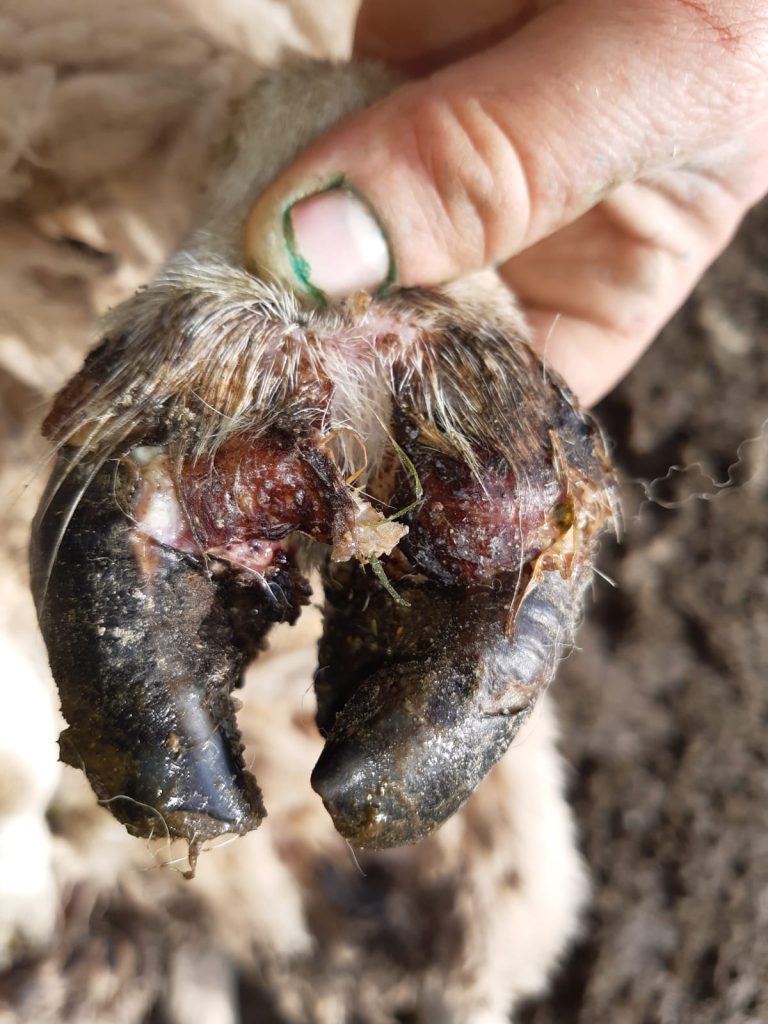Written by Dr T.B Barragry PhD, MSc, MVM, MRCVS, Dip ECVPT.
Lameness in sheep is a major welfare concern and causes very significant financial and production losses. Over 80% of flocks are affected by lameness, and within the flock the incidence is believed to run at 15%-20%.
If a lamb is lame, it will take longer to reach market weight. If the ewe is lame, milk production goes down and in consequence, meat production of the lamb goes down. Lameness is one of the biggest problems in farming and the condition causes considerable morbidity, by impacting negatively on productivity and economic returns. It can be considered as a “gateway disease” leading to other economically important health problems, especially in sheep. Lameness is also a major animal welfare issue, and its serious visual impact with welfare implications, negatively impacts public perception especially in the case of sheep farming. Lameness can cause intense pain to the animal which will often be seen lying down or walking on its knees.
Brief Summary of Some Types of lameness in Sheep
Scald occurs between the hoof horns and is usually a reddish discolouration and moist with the loss of hair. Inflammation occurs in the skin between the digits. With scald, there is generally no bad smell and little or no involvement of the hoof. It can be a precursor to footrot.

Footrot is a disease of the hoof that originates between digits but develops to an under-run hoof and it also has a distinctive smell. Footrot is highly infectious and is transmitted from sheep to sheep and thus proper control and prevention must focus on the whole flock. It is particularly transmissible when sheep are confined in a small area e.g., during housing periods, in handling yards, contaminated bedding or access routes. A very useful vaccine is available to prevent and reduce the incidence of footrot disease. It is widely used and a successful deterrent. In most flocks, footrot (interdigital dermatitis) is the most common cause, accounting for approximately 80% of foot lameness. Most outbreaks of lameness in sheep are caused by this bacterial infection. It is a highly infectious disease and can be caused by two bacteria Dichelobacter Nodosus and Fusobacterium necrophorum. Scald and footrot represent about 90% of all lameness on sheep farms.

Contagious ovine digital dermatitis (CODD) is regarded as one of the most severe foot conditions affecting sheep and is associated with Treponema bacteria. Sheep suffering from cases of CODD can be left permanently lame due to changes to underlying tissues and bone within the hoof. This condition starts at the coronary band and then spreads to under run the hoof wall. There is no foul smell with this type, but it is contagious and can affect many sheep in a very short period.

Hoof Care and Footbaths
As with most conditions, “prevention is better than cure,” and regular foot baths every few weeks with a safe and effective compound is a sound financial investment. Efforts must be made to routinely prevent the appearance of foot problems in sheep before the actual clinical signs can occur, thus preventing a reservoir of infection building up in the flock.
Footbaths have been used as routine prophylactics for lameness for many years in sheep, and most of these have centred around copper, zinc, or formalin type ingredients. Formalin is known to harden the hoof and is also carcinogenic – chronic inhalation of its fumes must be avoided. Copper is environmentally toxic and is hazardous to sheep, plants, and herbage.
Vaccine
A very useful vaccine is available to prevent and reduce the incidence of the foot rot disease. It is widely used and is a successful deterrent.
Hoof Care and Footbaths
As with most conditions, “prevention is better than cure” and regular foot baths with a safe and effective compound is a sound financial investment. Footbaths have been used as routine prophylactics for lameness for many years and most have centred around copper, zinc, or formalin type ingredients.
Some new alternatives for hoof care are now available which on the basis of clinical field trials hold up very well when compared to copper or formalin. In addition, these newer compounds are safer to the handler and less toxic to the environment. Formalin for instance is known to be carcinogenic, toxic, and irritant, and copper is environmentally toxic and can be toxic to sheep.
New Alternative
A new alternative to these traditional types of footbaths is Tea Tree oil (TTO), an essential oil which has been shown to have many beneficial medicinal uses as an antiseptic, anti-inflammatory, antifungal, and antibacterial agent, where it is used routinely in skin and epidermal care. TTO has been proven to have potent antibacterial and anti-inflammatory actions and also promotes health in the hoof keratin.
Hoofsure Endurance from Provita is a proven and safe footbath solution, a proprietary blend of organic acids, tea tree oil, and wetting agents. It has been highly successful in the field in both sheep and cattle, in preventing lameness and thereby avoiding the heavy financial costs arising from the subsequent appearance of lameness. The range also includes Konquest hoof gel and Combat hoof spray for topical application.

Studies
An independent study on the effectiveness of footbath solutions in sheep found that 65% of sheep improved after one pass through a footbath containing Hoofsure Endurance at 2% dilution rate.
References available on request.
SPECIAL OFFER: BUY Hoofsure Endurance 20 litre, Konquest Gel 30g and Combat Spray 500ml and GET FREE Sheep footbath!